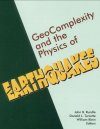About this book
Earthquakes in urban centers are capable of causing enormous damage. The January 16, 1995 Kobe, Japan earthquake was only a magnitude 6.9 event and yet produced an estimated $200 billion loss. Despite an active earthquake prediction program in Japan, this event was a complete surprise. Similar scenarios are possible in Los Angeles, San Francisco, Seattle, and other urban centers around the Pacific plate boundary. The development of forecast or prediction methodologies for these great damaging earthquakes has been complicated by the fact that the largest events repeat at irregular intervals of hundreds to thousands of years, resulting in a limited historical record that has frustrated phenomenological studies. The papers in Geocomplexity and the Physics of Earthquakes describe an emerging alternative approach, which is based on a new understanding of earthquake physics arising from the construction and analysis of numerical simulations. With these numerical simulations, earthquake physics now can be investigated in numerical laboratories. Simulation data from numerical experiments can be used to develop theoretical understanding that can be subsequently applied to observed data. These methods have been enabled by the information technology revolution, in which fundamental advances in computing and communications are placing vast computational resources at our disposal.
Contents
Preface
J. B. Rundle, D.L. Turcotte, and William Klein ix
Introduction
John B . Rundle, Donald L. Turcotte, and William Klein 1
Models
Deterministic Chaos in two State-variable Friction Sliders and the Effect of Elastic Interactions
Thorsten W. Becker 5
Spring-block Models of Seismicity: Review and Analysis of a Structurally Heterogeneouos Model Coupled to a Viscous Asthenosphere
Jon D. Pelletier 27
Statistical Anlysis of a Model for Earthquake Faults With Long-range Stress Transfer
W. Klein, M. Anghel, C. D. Ferguson, J. B. Rundle, and J. S. S. Martins 43
Traveling Wave and Rough Fault Earthquake Models: Illuminating the Relationship Between Slip Deficit and Event Frequency Statistics
Susana J . Gross 73
A Statistical Physics Approach to Earthquakes
D. L. Turcotte, W. I. Newman, and A. Gabrielov 83
Earthquakes: Friction or a Plastic Instability?
D.C. Roberts and D. L. Turcotte 97
Lattice Solid Simulation of the Physics of Fault Zones and Earthquakes: The Model, Results, and Directions
P. Mora, D. Place, S. Abe, and S. Jaum 105
Patterns
Dynamics of Seismicity Patterns in Systems of Earthquake Faults
John B. Rundle, W. Klein, Kristy Tiampo and Susanna Gross 127
Constraints from Field and Laboratory Data
Microscopic and Macroscopic Physics of Earthquakes
Hiroo Kanamori and Thomas H. Heaton 147
Depth Dependent Rupture Properties in Circum-Pacific Sub-duction Zones
Susan L. Bilek and Thorne Lay 165
Effects of Loading Rate and Normal Stress on Stress Drop and Stick-Slip Recurrence Interval
Stephen L. Karner and Chris Marone 187
Changes in Earthquake Size-Frequency Distributions Underlying Accelerating Seismic Moment/Energy Release
Steven C. Jaum 199
Observation of Systematic Variations in Non-local Seismicity Patterns from Southern California
K. F. Tiampo, J. B. Rundle, S. McGinnis, S. J. Gross, and W. Klein 21
Computational Methods
Introducinag New Paradigm for Computational Earth Science: A Web-Object-Based Approach to Earthquake Simulations
Geoffrey C. Fox, Ken Hurst, Andrea Donnellan, and Jay Parker 219
Modeling Complex Crustal Processes
William J. Bosl 245
Crustal Fluids and Earthquakes
William J. Bosi and Amos Nur 267
Customer Reviews





































